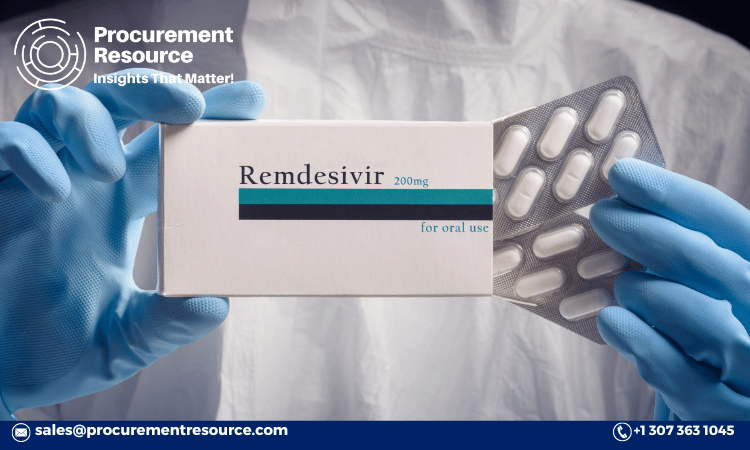Remdesivir, an antiviral medication initially developed for treating Ebola, has gained significant attention as a potential treatment for COVID-19. The drug has been authorized for emergency use in numerous countries and has played a crucial role in managing the pandemic. Understanding the production cost of Remdesivir is essential for pharmaceutical companies, healthcare providers, and policymakers to ensure its affordability and accessibility. This report delves into the various aspects of Remdesivir production, including the manufacturing process, raw material costs, and other relevant details.
Manufacturing Report and Process
The production of Remdesivir involves several intricate steps, starting from the synthesis of its active pharmaceutical ingredient (API) to the final formulation and packaging. The manufacturing process can be broadly divided into the following stages:
Request For Sample: https://www.procurementresource.com/production-cost-report-store/remdesivir/request-sample
- Synthesis of the Active Pharmaceutical Ingredient (API):
- The API synthesis is the most critical and complex part of the Remdesivir production process. It involves multiple chemical reactions and purification steps to ensure the high purity and potency of the API.
- Key intermediate compounds are synthesized through various chemical processes, including nucleophilic substitution, esterification, and cyclization.
- The final API is obtained after rigorous purification and crystallization steps to achieve the desired quality and stability.
- Formulation and Dosage Preparation:
- Once the API is synthesized, it is formulated into the final dosage form. For Remdesivir, this typically involves preparing a sterile lyophilized powder or a solution for intravenous infusion.
- The formulation process includes dissolving the API in appropriate solvents, adding stabilizers and excipients, and adjusting the pH to ensure the stability and efficacy of the final product.
- Filling and Packaging:
- The formulated product is then filled into sterile vials or ampoules under aseptic conditions to prevent contamination.
- The filled vials are sealed, labeled, and packaged for distribution. This step also involves quality control checks to ensure that the final product meets all regulatory standards.
- Quality Control and Assurance:
- Throughout the manufacturing process, stringent quality control measures are implemented to monitor the purity, potency, and safety of the product.
- This includes testing for impurities, microbial contamination, and ensuring that the product meets all specified criteria for release.
Raw Material Costs
The cost of raw materials significantly influences the overall production cost of Remdesivir. The primary raw materials used in the synthesis of Remdesivir include:
- Nucleoside Precursors:
- These are essential starting materials for the synthesis of the API. The cost of these precursors can vary depending on their availability and purity requirements.
- Chemical Reagents and Solvents:
- Various chemical reagents and solvents are used throughout the synthesis process. The cost of these materials depends on their purity, quantity, and the efficiency of the chemical reactions.
- Stabilizers and Excipients:
- Stabilizers and excipients are added during the formulation stage to ensure the stability and efficacy of the final product. These include substances like mannitol, sodium sulfobutylether-β-cyclodextrin (SBECD), and others.
- Packaging Materials:
- The cost of vials, stoppers, seals, labels, and packaging materials also contributes to the overall production cost. Ensuring the sterility and integrity of these materials is crucial for the final product’s safety.
Remdesivir Classification, Side Effects, Uses, Mechanism of Action, and Indications
Classification: Remdesivir is classified as a nucleotide analog prodrug. It is an antiviral medication that inhibits the replication of certain viruses by interfering with their RNA-dependent RNA polymerase.
Side Effects: Common side effects of Remdesivir include nausea, headache, and gastrointestinal discomfort. In some cases, patients may experience elevated liver enzymes, which require monitoring during treatment. Severe side effects are rare but can include allergic reactions and kidney dysfunction.
Uses: Remdesivir is primarily used to treat COVID-19 in hospitalized patients who require supplemental oxygen. It has shown efficacy in reducing the duration of symptoms and improving clinical outcomes in severe cases of COVID-19.
Mechanism of Action: Remdesivir works by inhibiting the viral RNA-dependent RNA polymerase, an enzyme crucial for viral replication. As a nucleotide analog, it incorporates into the viral RNA chain during replication, causing premature termination of RNA synthesis. This prevents the virus from multiplying and spreading within the host.
Indications: Remdesivir is indicated for the treatment of COVID-19 in hospitalized patients with severe symptoms, including those requiring supplemental oxygen or mechanical ventilation. It is also used in some cases for patients with moderate COVID-19 symptoms to prevent disease progression.
Latest News
The latest developments regarding Remdesivir have focused on its ongoing role in the treatment of COVID-19 and its potential applications for other viral infections. Recent news includes:
- Expanded Use and Approvals:
- Remdesivir has received expanded approvals in several countries for use in pediatric patients and other specific populations. Ongoing clinical trials are exploring its efficacy in different stages of COVID-19 and other viral diseases.
- Combination Therapies:
- Research is being conducted to evaluate the effectiveness of Remdesivir in combination with other antiviral drugs and immunomodulators. These combination therapies aim to enhance the overall efficacy of treatment and reduce the duration of illness.
- Supply and Distribution:
- Efforts are being made to ensure the adequate supply and equitable distribution of Remdesivir globally. Partnerships between pharmaceutical companies and governments are aimed at increasing production capacity and addressing supply chain challenges.
- Patent and Generic Production:
- Discussions regarding the patent status of Remdesivir and the production of generic versions have been ongoing. The availability of generic Remdesivir could significantly reduce costs and improve access, especially in low- and middle-income countries.
In conclusion, understanding the production cost of Remdesivir is crucial for managing its availability and affordability in the global fight against COVID-19. The intricate manufacturing process, coupled with the cost of raw materials, plays a significant role in determining the final price of this life-saving medication. As research continues and new developments emerge, Remdesivir remains a critical component of the therapeutic arsenal against viral infections.
